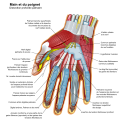Barakas:Wrist and hand deeper palmar dissection-numbers.svg

Ukuran pratayang PNG ini dari berkas SVG ini: 474 × 600 piksal Risulusi lain: 190 × 240 piksal | 379 × 480 piksal | 607 × 768 piksal | 809 × 1.024 piksal | 1.619 × 2.048 piksal | 555 × 702 piksal.
Ukuran asli (Barakas SVG, nominal 555 × 702 piksel, ganal barakas: 207 KB)
Riwayat barakas
Klik pada tanggal/waktu gasan manjanaki barakas ngini wayah itu.
| Tanggal/Waktu | Miniatur | Matra | Pamakai | Ulasan | |
|---|---|---|---|---|---|
| wayahini | 2 Juni 2015 01.15 |  | 555 × 702 (207 KB) | Perhelion | optimize image |
| 8 Juli 2012 19.42 |  | 555 × 702 (399 KB) | Wilfredor | optimize image | |
| 14 Januari 2009 05.11 |  | 555 × 702 (817 KB) | Wilfredor | {{Information |Description= |Source= |Date= |Author= |Permission= |other_versions= }} | |
| 17 Uktubir 2008 00.37 |  | 555 × 702 (815 KB) | Wilfredor | {{Information |Description= |Source= |Date= |Author= |Permission= |other_versions= }} | |
| 24 Juli 2008 03.33 |  | 770 × 767 (822 KB) | Bibi Saint-Pol | {{Created with Inkscape}} == {{int:filedesc}} == {{Information |Description= {{en|The hands (med./lat.: manus, pl. manūs) are the two intricate, prehensile, multi-fingered body parts normally located at the end of each arm of a human or other primate. Th |
Tautan barakas
Tungkaran nangini mamakai barakas ngini:
Pamakaian barakas global
Wiki lain nangini mamakai barakas ngini:
- Pamakaian pada af.wikipedia.org
- Pamakaian pada ar.wikipedia.org
- Pamakaian pada az.wikipedia.org
- Pamakaian pada bn.wikipedia.org
- Pamakaian pada br.wikipedia.org
- Pamakaian pada ce.wikipedia.org
- Pamakaian pada crh.wikipedia.org
- Pamakaian pada cv.wikipedia.org
- Pamakaian pada da.wikipedia.org
- Pamakaian pada de.wikipedia.org
- Pamakaian pada en.wikipedia.org
- Wikipedia:Featured picture candidates/Wrist and hand deeper palmar dissection-en.svg
- Wikipedia:Featured picture candidates/April-2009
- User:Madhero88/Medicalg
- Wikipedia:WikiProject Anatomy/Resources
- Wikipedia talk:WikiProject Anatomy/Archive 9
- User talk:Rhododendrites/Reconsidering FPC on the English Wikipedia
- Pamakaian pada es.wikipedia.org
- Pamakaian pada fa.wikipedia.org
- Pamakaian pada fr.wikipedia.org
- Pamakaian pada hr.wikipedia.org
- Pamakaian pada hu.wikipedia.org
- Pamakaian pada id.wikipedia.org
- Pamakaian pada incubator.wikimedia.org
- Pamakaian pada iu.wikipedia.org
- Pamakaian pada ko.wikipedia.org
- Pamakaian pada lbe.wikipedia.org
- Pamakaian pada lb.wikipedia.org
- Pamakaian pada lt.wikipedia.org
- Pamakaian pada ms.wikipedia.org
- Pamakaian pada nia.wiktionary.org
- Pamakaian pada os.wikipedia.org
- Pamakaian pada pl.wikipedia.org
- Pamakaian pada pt.wikipedia.org
- Pamakaian pada ru.wikipedia.org
Lihat labih banyak pamakaian glubal matan barakas ngini.







